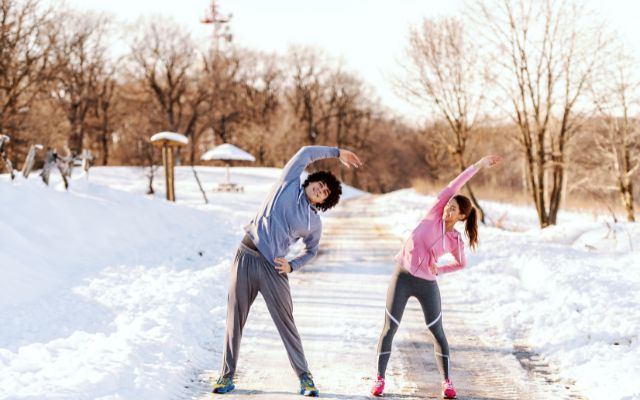Winter Fitness: Safety Tips For Exercising Outdoors

Winter Fitness: Winter is a magical time of the year, with its snow-covered landscapes and the joy of the holiday season. However, when it comes to staying fit during this chilly season, many people prefer to stay cozy indoors. But did you know that exercising outdoors in winter can be a fantastic way to stay active and make the most of the season? To do so safely, you need to be aware of some key tips that will keep you warm, healthy, and injury-free. In this article, we’ll explore the essential safety tips for winter fitness and how to make the most of your outdoor workouts.
Safety tips for winter fitness and how to make the most of your outdoor workouts
- Dress in Layers
When you exercise outdoors in the winter, the key to staying warm is layering. Start with a moisture-wicking base layer to keep sweat away from your body. Next, add an insulating layer for warmth, like a fleece or down jacket. Finally, wear a waterproof and windproof outer layer to protect against the cold and wind. Don’t forget a good pair of thermal socks, gloves, and a hat to keep extremities warm. - Choose the Right Footwear
Proper footwear is essential for winter workouts. Opt for winter-specific running or hiking shoes with good traction to prevent slips and falls. If it’s extremely cold, consider adding thermal insoles to keep your feet warm. - Stay Visible
Winter days are shorter, and the sun sets earlier, so it’s essential to be visible to others, especially if you’re exercising in the early morning or late afternoon. Wear reflective clothing or accessories and carry a flashlight or headlamp to ensure you’re seen by motorists and other pedestrians. - Warm Up Properly
Cold muscles are more prone to injury, so it’s crucial to warm up adequately before your workout. Start with some light cardio, like jumping jacks or brisk walking, and follow with dynamic stretches to prepare your muscles for action. - Hydrate and Protect Your Skin
Although it’s cold, you still need to stay hydrated during winter workouts. Dehydration can occur even in colder weather, so be sure to drink water before, during, and after your exercise session. Also, protect your skin from the cold by applying a moisturizing sunscreen to prevent windburn. - Be Mindful of Frostbite and Hypothermia
Frostbite and hypothermia are real dangers in cold weather. Keep an eye on your extremities (fingers, toes, nose, and ears) for signs of frostbite, like numbness or discoloration. If you suspect frostbite, seek shelter and warm up the affected area. Hypothermia, on the other hand, can occur if you become too cold. Dress appropriately and listen to your body—if you start shivering uncontrollably, it’s time to go inside. - Plan Your Route
Choose a safe route for your winter workouts. Avoid areas with ice, and opt for well-lit paths or streets. If possible, let someone know where you’re going and when you expect to return, just in case. - Embrace Outdoor Winter Activities
Winter provides an opportunity to try exciting activities like cross-country skiing, snowshoeing, ice skating, or even a friendly snowball fight. These activities can be great workouts and make the most of the season’s unique offerings. - Listen to Your Body
Your body is your best guide. If you feel uncomfortable, experience pain, or just don’t feel right during your winter workout, it’s essential to stop and seek shelter. There’s no shame in rescheduling your exercise for a warmer day. - Stay Consistent
Consistency is key to any fitness routine, and that includes winter workouts. Don’t let a little chill deter you from your fitness goals. With the right gear and precautions, you can make winter a productive and enjoyable time for staying active.
Conclusion
Staying fit during the winter months can be a rewarding experience, but it requires some extra care and attention to safety. By dressing appropriately, being mindful of weather-related risks, and listening to your body, you can enjoy outdoor workouts while making the most of the winter wonderland. So, grab your gear, bundle up, and embrace the cold – your health and well-being will thank you!
FAQ
Q1: Is it safe to exercise outdoors during the winter?
A1: Yes, it’s safe to exercise outdoors in the winter with the right precautions. Dress in layers, stay visible, warm up properly, and be aware of potential cold-related risks like frostbite and hypothermia.
Q2: What should I wear when exercising in cold weather?
A2: Dress in layers, starting with moisture-wicking base layers, insulating layers for warmth, and windproof and waterproof outer layers. Don’t forget thermal socks, gloves, and a hat.
Q3: Are there specific types of shoes for winter workouts?
A3: Yes, it’s advisable to wear winter-specific running or hiking shoes with good traction to prevent slips and falls. Thermal insoles can be added for extra warmth.
Q4: How can I stay visible during early morning or late afternoon workouts in winter?
A4: Wear reflective clothing or accessories, and carry a flashlight or headlamp to ensure you’re visible to others, especially motorists.
Q5: What’s the best way to warm up in cold weather?
A5: Start with light cardio exercises like jumping jacks or brisk walking, followed by dynamic stretches to prepare your muscles for action.
Q6: Is staying hydrated important in cold weather workouts?
A6: Yes, it’s essential to stay hydrated, even in cold weather. Be sure to drink water before, during, and after your workout.
Q7: What are the signs of frostbite and hypothermia, and how can I prevent them?
A7: Signs of frostbite include numbness and discoloration of extremities. Hypothermia can cause uncontrollable shivering. To prevent these conditions, dress appropriately and seek shelter if you experience symptoms.
Q8: Are there specific routes I should choose for winter workouts?
A8: Select well-lit paths or streets, avoiding areas with ice. Let someone know your workout plans and expected return time for safety.
Q9: What other outdoor winter activities can I try for fitness?
A9: You can embrace activities like cross-country skiing, snowshoeing, ice skating, or even snowball fights, which provide both fun and exercise.
Q10: How do I know when it’s time to stop a winter workout and seek shelter?
A10: Listen to your body. If you feel uncomfortable, experience pain, or just don’t feel right during your winter workout, it’s essential to stop and seek shelter.
- Physical Therapy For Osteoporosis: A Complete Report
- Benefits Of Exercise : 10 Key Benefits Of New Exercise Bike
Q11: Can I maintain a consistent fitness routine during the winter?
A11: Absolutely! Consistency is essential for any fitness routine. With the right gear and precautions, you can make winter a productive and enjoyable time for staying active.



